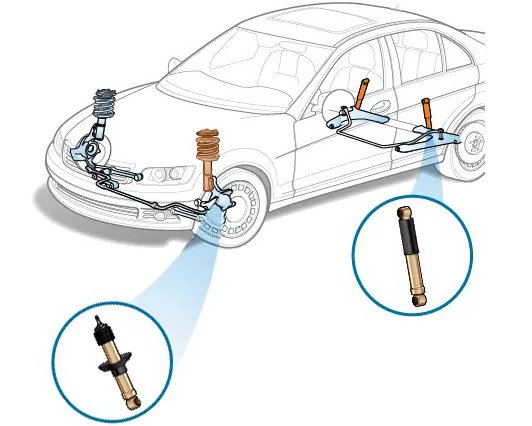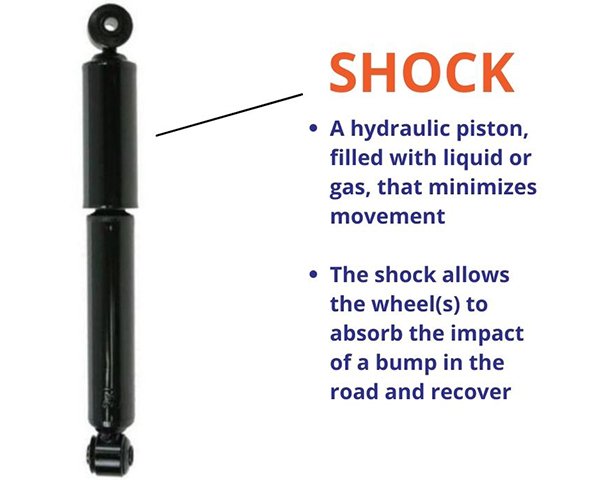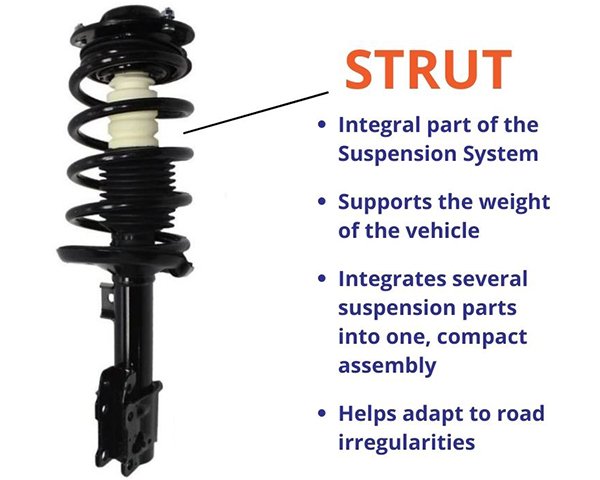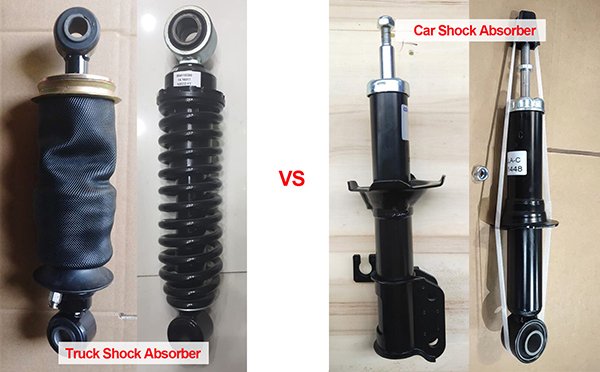Imagine yourself driving along the road, and your car is floating smoothly on the bumps and dips. Many people want to know Where Are Shock Absorbers Located. It’s all because of a hero, staying hidden in automotive engineering – the shock absorber.
Shock absorbers are located behind the tires of a vehicle, together with springs. They can prevent excessive bouncing and ensure the stability of the ride. Shock absorbers are one of the most important parts of the suspension system, which can make driving more comfortable and safe.
Let’s delve deeper into their functionality and significance.
Are Shocks Positioned in the Front or Back of a Vehicle?

Shock absorbers, also called shocks, are set on both the front and the back of most vehicles. They are used to absorb and dampen the impact from the road, making the ride smoother by reducing bounce and sway as the vehicle moves.
In the front, shocks are often part of the strut assembly. The strut assembly combines the shock absorber with a coil spring to support the weight of the vehicle and allow for steering.
In the rear, shocks may be separate components or part of the same assembly, depending on the vehicle’s suspension design. The configuration can vary widely depending on the type of vehicle, its design, and its intended use. For example, trucks and SUVs designed for off-road use might have different shock absorber setups compared to passenger cars focused on comfort.
How Can You Identify the Location of Your Shock Absorbers?

To identify the location of your shock absorber, you can do a simple visual inspection on your vehicle. Here is the way to find it out:
Step 1: Safety First
Before you begin, please ensure that your vehicle is parked on a level ground, the parking brake is applied, and the engine is switched off. If you are going to work with or under the vehicle, please make sure it is properly supported if lifted by a jack with jack stands. Never get under a vehicle supported only by a jack.
Step 2: Visual Inspection of the Front Suspension
- Look Under the Hood: Sometimes, the top part of the front shock absorbers or struts can be seen when you open the hood. They might be visible near the top of each wheel well.
- Inspect the Wheel Wells: Kneel down in front of your car and look into the wheel wells over the front tires. If your car has struts, you will see a big component with a spring around it. As for traditional shock absorbers, look for a cylindrical component that is connected to both the suspension and the body or frame of the car.
Step 3: Visual Inspection of the Rear Suspension
- Inspect the Rear Wheel Wells: Go to the rear of the vehicle and check the part above the rear tires in the wheel wells. Depending on your vehicle design, you may find separate shock absorbers or a strut assembly similar to the front. The shocks are attached near the axle in trucks or vehicles with a solid rear axle.
- Look Underneath the Vehicle: If the shocks are not easily visible from the side, you might need to look underneath the vehicle’s rear. You’re looking for the same cylindrical components as in the front, running vertically between the lower suspension components and the vehicle’s body or frame.
What Impact Do Shock Absorbers Have on Vehicle Performance?

Shock absorbers are very important for vehicle performance. They have influences on many aspects of driving, handling, and safety. The main function of shock absorbers is to absorb and dampen the shock from road surfaces. It will affect vehicle performance in the following aspects:
1.Ride Comfort
- Absorb Road Bump: The shock absorber can absorb the vibration and jolt from road bumps, which makes the passengers feel more comfortable.
- Reducing Bounce: When the car bumps or sinks, the shock absorber can reduce the oscillation (bounce) of the car, and make it back to the normal driving condition immediately.
2.Handling and Stability
- Enhanced Tire Contact: Excellent shock absorbers can maintain the tires in optimal contact with the road surface, which is crucial for safe steering, braking, and acceleration.
- Cornering Stability: It helps keep vehicle stability during turns, reducing body roll and allowing for safer and more confident cornering.
3.Safety
- Braking Performance: Well-functioning shock absorbers can help reduce braking distances by ensuring consistent contact between tires and the road.
- Prevention of Skidding and Aquaplaning: In wet conditions, effective shock absorption can help prevent skidding and hydroplaning by maintaining tire contact.
4.Vehicle Longevity
- Protection of Suspension Components: Shock absorbers can reduce the wear and tear of other suspension parts by absorbing most of the road impacts.
- Reduced Stress on the Vehicle Frame: Meanwhile, they also reduce the stress on the frame and bodywork by damping the impact forces transmitted through the suspension.
5.Efficiency
- Aerodynamics: Shock absorbers in vehicles with adaptive or active suspension systems can adjust vehicle height or stiffness to achieve optimal aerodynamic efficiency at different speeds, indirectly affecting fuel efficiency.
How Do Shocks and Struts Differ?
Shocks (shock absorbers) and struts are both crucial components of a vehicle’s suspension system, but they have different designs and functions. Below are their differences:

Shock Absorbers
- Function: Shock absorbers absorb and dampen impacts from road surfaces, controlling the movement of the vehicle’s springs and suspension. They prevent excessive bouncing and ensure that the tires maintain contact with the road.
- Structure: A shock absorber is a separate part that is not responsible for supporting the weight of the vehicle. It consists of a cylinder filled with gas or oil and a piston that moves inside the cylinder as the suspension flexes.
- Location: Manufacturers install shocks on both front and rear suspension systems, but they do not serve as structural suspension components. They connect the vehicle chassis and suspension (either the axle or the control arms).

Struts
- Function: Struts play two important roles. They are responsible for the structural support of the vehicle’s suspension, like a shock absorber. Meanwhile, it also bears the weight of the vehicle, unlike a common shock absorber. Struts are parts of the structural suspension of the vehicle and affect the alignment angles.
- Structure: A strut is a more complex assembly that includes a shock absorber, spring, and structural components. It often integrates the coil spring and a shock absorber into one compact unit and serves as a pivotal point for steering.
- Location: Many modern vehicles use struts in the front suspension and some rear suspensions. They are essential to the steering system of a vehicle and have a great effect on the alignment adjustment.
Key Differences
- Supporting Vehicle Weight: Struts are a part of a vehicle’s structural support system, which directly bears the weight of the vehicle. While shock absorbers do not support weight, they only control the speed of weight transfer in a vehicle during suspension movement.
- Effect on Wheel Alignment: Since struts are a structural part of the suspension system, they will affect the alignment of the vehicle. If you change a strut, you need to do an alignment service. But for shock absorbers, you can replace them without any effect on alignment.
- Complexity and Cost: Struts are generally more complex and expensive than shock absorbers since they are a critical part of vehicle suspension and steering systems. They require more components and affect the vehicle’s handling and alignment.
Shock Absorbers in Trucks vs. Cars: Any Differences?

Shock absorbers in trucks and cars differ primarily because these vehicles have distinct demands and purposes. Here is a detailed comparison:
Load Handling and Size
- Trucks: Shock absorbers in trucks are designed to handle heavier loads and more strenuous working conditions. Trucks, especially those used for towing and carrying heavy loads, require shocks that can withstand greater forces and weight without compromising performance. Therefore, truck shock absorbers are often larger, more robust, and have a greater fluid capacity to manage the increased heat generated from heavier loads.
- Cars: Cars generally have lighter loads compared to trucks. Consequently, they design their shock absorbers for lighter duty, prioritizing passenger comfort and handling precision over heavy-duty load-bearing capacity. Car shocks are typically smaller in size and have less fluid capacity because they deal with less severe forces and heat buildup.
Design and Technology
- Adjustability: Some truck shock absorbers offer adjustability features to accommodate varying load conditions and off-road performance needs. This can include adjustable damping rates to handle different terrains and load sizes.
- Standard Cars: Car shock absorbers maintain a fixed balance between comfort and handling, eliminating the need for adjustability. High-performance cars might have sports-tuned shocks or even adaptive damping systems for enhanced handling, but these are less common in regular passenger vehicles.
Durability and Construction
- Trucks: Because of the rugged use and heavier loads, truck shocks always use thicker materials and more durable components to bear rougher conditions and longer service intervals. They may also use larger pistons and stronger seals to bear the extra strain.
- Cars: Although the durability of car shock absorbers is also necessary, the emphasis is more on a smooth ride and precise handling. The construction is a little less heavy-duty than truck shocks to optimize comfort and performance for daily driving conditions.
Suspension Type
- Truck Suspension Variability: Truck suspensions vary widely, from traditional leaf springs to advanced air suspension systems, so the shock absorbers are different in design and type. For heavy-duty trucks, the shock absorbers should be tough enough for the solid leaf spring suspensions.
- Cars: Usually adopt coil spring or strut-based suspension systems, which need a different type of shock absorber, integrated into or working with the suspension setup to offer a balanced ride quality and handling performance.






